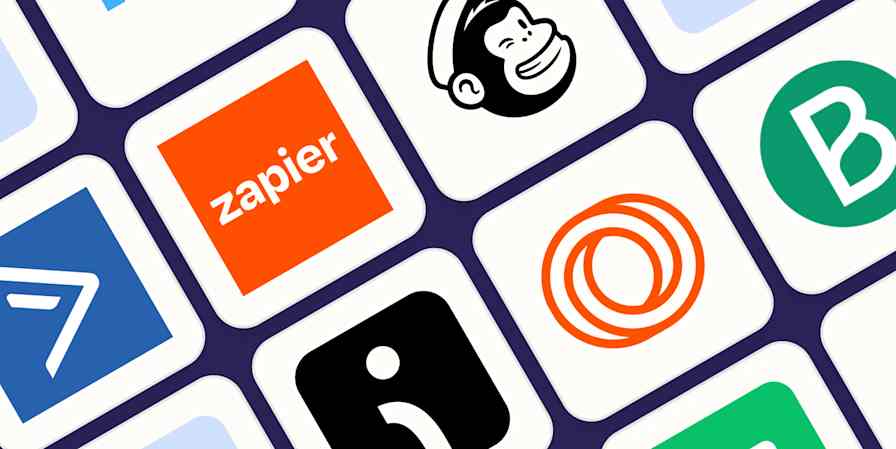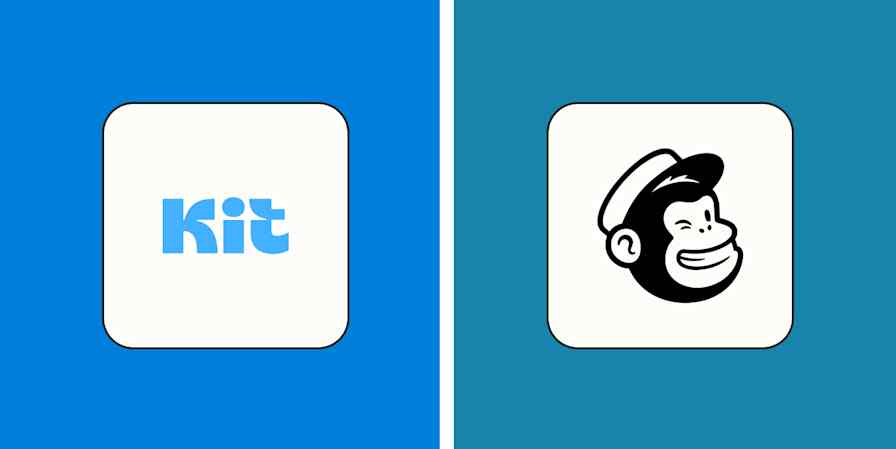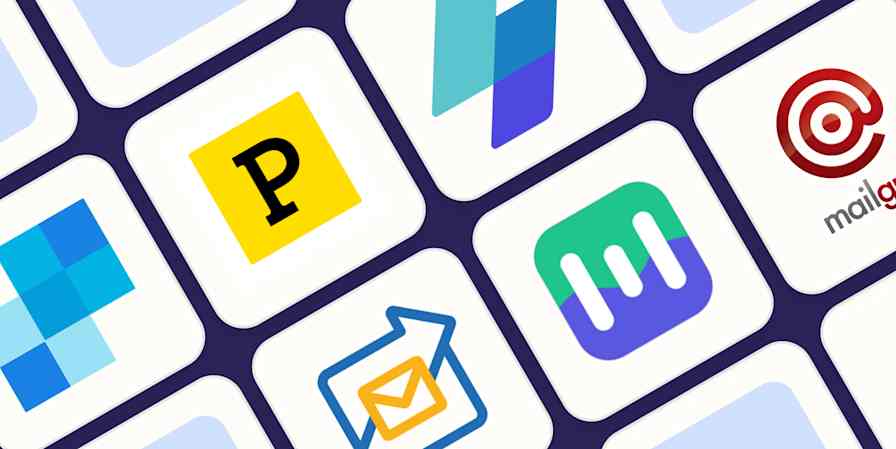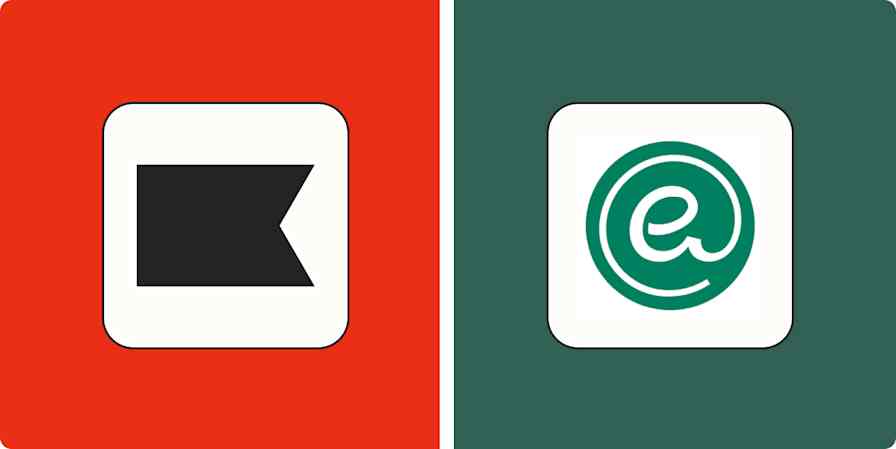Email marketing requires a battle plan. You've seen your own inbox; you know that it's chaos. You submit your email address as a required part of a purchase, and suddenly you're getting 60 emails a month from a mattress company, wondering why on earth they think someone who just bought a mattress would be in the market for more mattresses.
Want to stand out in a sea of mattress emails? You're going to need a strategy. We'll walk you through our favorite email marketing best practices and accompanying examples to help you kick off your next campaign.
Table of contents:
Email marketing strategy
1. Use an email marketing platform
If you're launching an email campaign, forget regular providers like Gmail and Outlook. In order to manage even a moderate volume of emails and subscribers, you're going to need an email marketing platform.
Platforms like ConvertKit, Mailchimp, and Moosend are designed as all-in-one tools that provide marketers with everything they need to run an email campaign. These tools can store and sort your contacts, track key metrics like email opens and bounce rates, and allow you to test out different versions of the same email to make sure you're sending the most effective one.
There are a lot of email marketing tools out there, but you might need a more specific type of software based on your goals and budget. Here are some resources to help you pick the one that's best for you:
2. Time your marketing emails
Make use of your email platform's scheduled send feature, and be mindful of time zones—a 2 a.m. email is going to go unread almost 100% of the time.
There are a lot of conflicting opinions as to when the best day and time are for sending marketing emails, and different tests often turn up different answers. Experts generally recommend sending midweek (Tuesday through Thursday) during work hours, but different audience demographics will have different preferences. The best way to figure out what time you should send your emails is to test different times and measure your results.

3. Align your brand voice and tone
Anyone who watched "Roseanne" remembers how jarring it was when Becky switched actresses mid-series. Suddenly, a new face was playing the same character, leaving viewers scratching their heads. If your emails sound like they come from different personalities, your audience might feel similarly disconnected or unsure about your brand's identity.
To avoid this, make sure every communication—regardless of who's sending it—reflects your brand's established voice and tone. Whether it's casual and friendly or formal and professional, consistency helps build a cohesive identity that your audience can recognize and trust. By maintaining a uniform voice, your brand becomes more relatable and memorable, much like knowing exactly what to expect when you visit the Conner residence in Lanford, IL.
4. Set SMART goals
When setting goals for your email campaign, make sure they follow the SMART framework: specific, measurable, attainable, relevant, and time-bound. SMART goals give you a concrete target to work toward and make it easy to track your progress. They also inform the type of email content you send, who you send it to, and how you measure success.
Aiming to "improve email performance," for example, is like saying you want to "get fit" while lounging on the couch with a box of Zebra Cakes. Vague goals give you permission to be lazy. Instead, commit to something like, "I want to increase click-through rate by 15% in six weeks by creating more engaging content and optimizing my CTAs."
Email list building
5. Set up opt-ins
An "opt-in" is the process of a reader or buyer confirming that they want to receive your email newsletter, either by clicking a button to sign up, indicating that they want to receive emails from you in a form, or checking a box to receive your emails when they're signing up for your app or service.
In a "double opt-in," someone who signs up will then receive an email asking them to confirm that they want to sign up. Subscribers will only receive your emails after they click the link in that confirmation email. This email is important since it verifies that they do actually want to sign up with that email address (in case someone else entered their email address), and it can help prevent you from getting in trouble for sending spam. (More on spam laws later.)

6. Set up auto tags for signups
Most email marketing platforms provide a way for users to automatically organize and tag contacts as they come in from different opt-in channels and when a subscriber performs a particular action.
For example, contacts who opt in by checking a box while making a purchase can be tagged as "customers," and subscribers that click on an in-email product link can be tagged as "prospects." This will allow you to tailor your emails to different subscribers' specific needs and interests without sorting through contacts and customizing individual emails by hand.
7. Use a variety of signup forms
The more signup forms you use, the more opportunities you have to collect new email contacts. Consider adding forms in the following spots:
At the end of each blog post
On your purchase confirmation page
On your site's "About" page
At the beginning of chatbot interactions
On your "Contact us" page
8. Add a pop-up form
The jury's still out on whether pop-up forms are worth the annoyance or not, but the fact that so many major brands and companies still use them suggests that they're at least worth considering. If you're not sold on pop-ups but want to give them a try, use an app like Sumo to run an experiment. You can also use a service like Exit Monitor or HubSpot to track users' mouse movements and trigger a pop-up as they're getting ready to exit the page.
9. Offer an incentive
In addition to adding forms in different locations, you should offer a variety of reasons for users to sign up. I rarely open newsletters, but I'll never say no to a discount code in exchange for an email signup.
Consider offering things like:
Reports and white papers
Discount codes
Sale alerts
Downloadable tools and templates
A free session or sample product
An email course
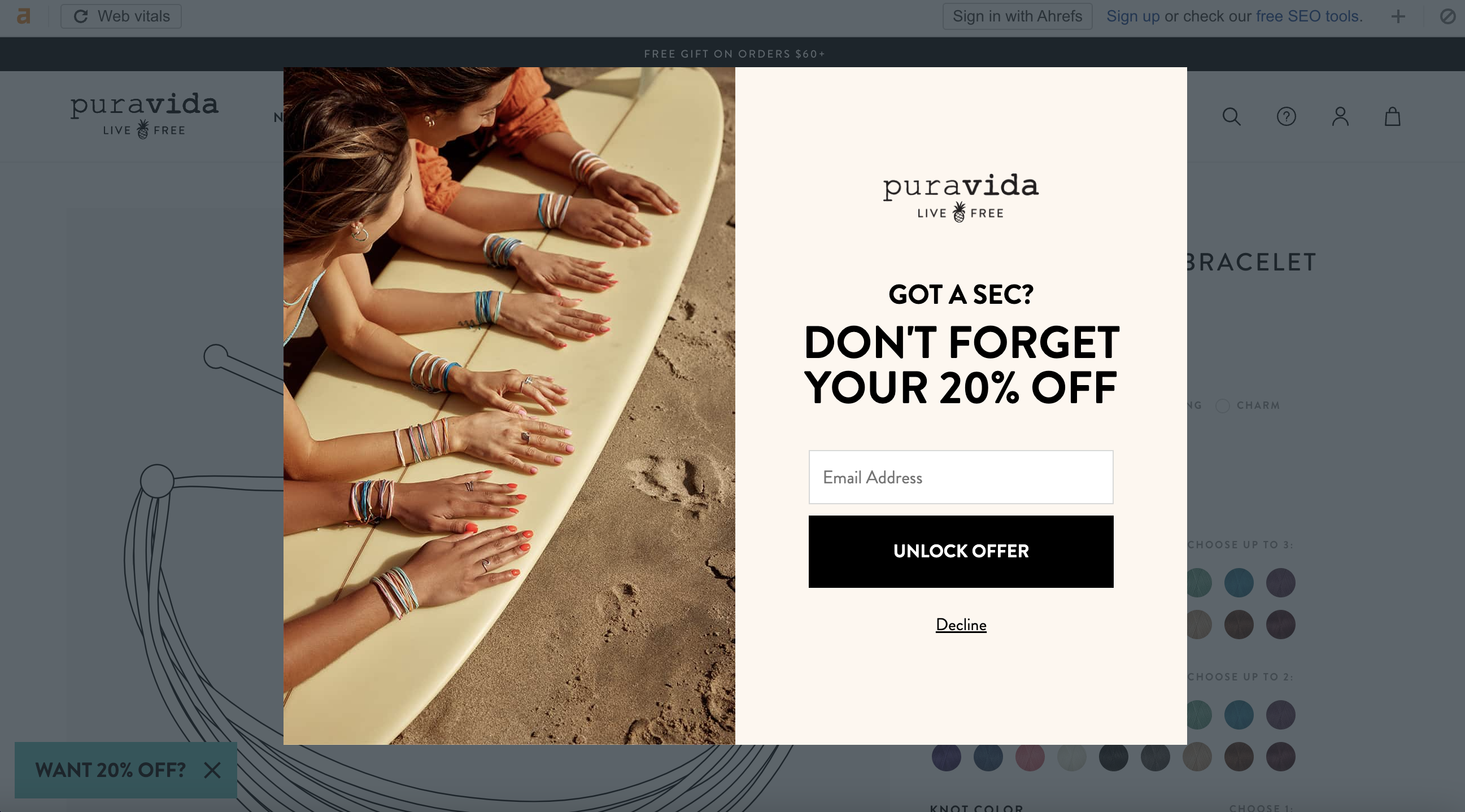
10. Import contacts from other sources
Set up integrations between your email marketing platform and other apps so you can collect and tag contacts from those sources as well. If you're hosting events with GoTo Webinar, selling tickets with Eventbrite, or managing prospects with Salesforce, your email marketing platform can organize all of those email addresses automatically. Here are some more tips on how to automatically import contacts into your email marketing software.
11. Don't buy contacts
Starting an email list from scratch can feel daunting at first, but resist the temptation to buy contact lists from third parties. Not only is this sometimes illegal, but it's also ineffective. People who didn't opt in and have never heard of you or your brand aren't going to open your emails anyway, so adding them to your database is a waste of time and money.
12. Clean your contact list regularly
When your campaigns have consistently low open rates, your emails are more likely to get marked as spam. That's why it's important to go through your contact list every few months and purge contacts who don't ever open your emails. If 25 people are going to open your email either way, 25 out of 50 is a much better open rate than 25 out of 100. Here are more tips for how to clean your email list.
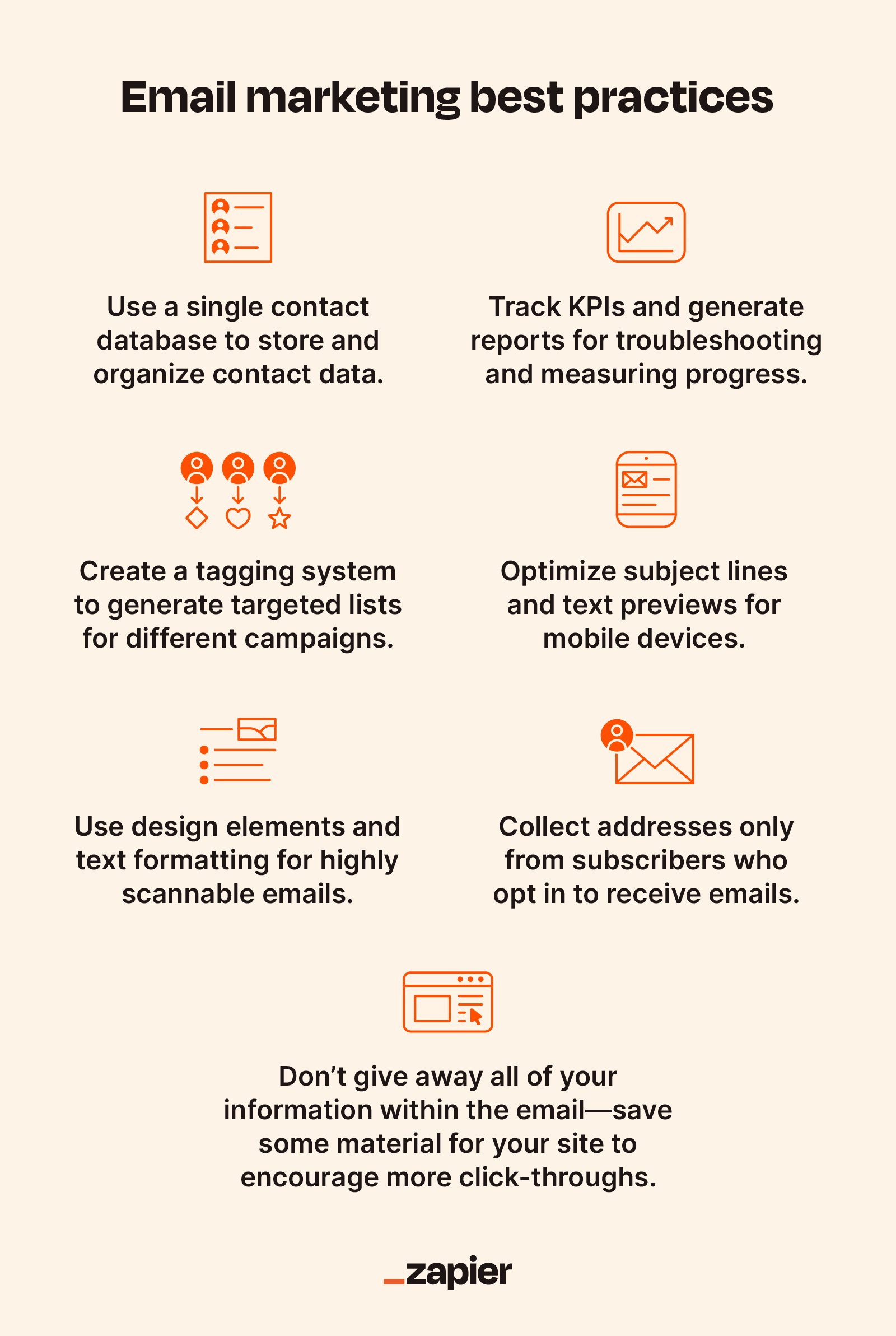
Designing emails that convert
13. Change sender identity when appropriate
Another benefit of using an email marketing platform is that it allows you to send from different personas. Not that you should pretend to be someone else or invent an alter ego, but there are some times when sending from someone different makes sense. For example:
To have a junior marketer or assistant send a campaign on your behalf
To send emails on behalf of a client
To match sender identity to your audience segment (target financial industry workers with emails from the CFO, for instance)
For example, Travis Dailey at Clearscope uses his name to send out emails on upcoming webinars and events. For more general updates, Clearscope uses the Team at Clearscope sender identity.

14. Avoid using no-reply email addresses
Make sure your emails are being sent from a real person—avoid using a "no-reply@" email address whenever possible. Not only is it cold and impersonal, but it can also decrease deliverability since no-reply addresses are more likely to be filtered as spam.
15. Utilize email previews
Use a tool like Mailchimp's Inbox Preview to find out what your emails will look like in people's inboxes, on both desktop and mobile.
Don't use character counts to make sure your subject lines will fit. Because some letters are physically wider than others, character counts aren't always accurate—a 60-character subject line might fit if it has a lot of lowercase l's and i's but get cut off if it's heavy on capital O's and D's.
16. Keep it short
As a chronically long-winded individual, this is one that took me a long time to accept: emails should be short—no matter how much you have to say. If you have a long message, turn it into a blog post or site copy, and then use your email as a preview with a click-through to the real content.

Emails that don't ask a lot of the reader are more successful than emails that immediately appear dense or like they're going to require a lot of focus. MarketingProfs offers a table of contents at the top of their emails giving readers a preview of what's in store, but the meatier content is saved for after the jump.
17. Place your value-add at the top
For the same reason that your emails should be short, they should also lead with the most valuable and actionable information. Emails have to hook their readers quickly. If you place the valuable or actionable information at the bottom or buried within dense text, subscribers will probably stop reading before they even get to the important part.
18. Keep it simple and skimmable
Increase the likelihood that subscribers actually read your entire email by keeping it as skimmable as possible. Think about the difference between a page of 12-point Times New Roman and a page with headers, subheaders, and bullets. Which is going to be easier to read? User text formatting to guide the eye and make your emails easy to consume.
Busy patterns and tons of bright colors are the visual equivalent of a wall of dense text—they tire readers' eyes out. Stick to one or two colors and fonts, and keep complicated illustrations to a minimum.

This email from Cision is short and easy to skim, but it's still packed with key information. It's visually interesting without being overwhelming.
19. Keep it consistent
Create or use templates that utilize the same or similar colors and fonts in order to present a cohesive brand identity. A little visual consistency can make the difference between an email that looks homemade and amateur versus one that looks clean, professional, and impressive.
Check out our guide to B2B email marketing best practices for more tips on email architecture and design.
20. Write engaging subject lines
The most effective subject lines are personal, promotional, and engaging. Exactly how that shakes out will depend on your industry and your target audience.
For an eCommerce business selling women's clothing to twentysomethings, that might look like incorporating Gen Z slang, nodding to popular songs or TV shows, and teasing sales. For a B2B SaaS company, that might look like reeling customers in with information about upcoming webinars or new industry reports.

If you find your eyes glazing over trying to drum up a catchy subject line, AI can help. There are many AI text generators that offer specific email subject line templates to help you create better subject lines.
Keep these subject line best practices in mind:
Include a deadline in the subject line (this works well for sales and signup deadlines)
Ask open-ended questions to pique readers' interest
Avoid words associated with spam such as "free" or "last chance"
Keep subject lines around 40 characters or five to seven words


21. Provide a seamless mobile experience
You're probably putting your marketing emails together on a desktop, but it's likely that most people will be reading them on mobile—that's why you need to test on a variety of platforms before sending.
Most email platforms can resize images and text and condense everything into one clean column to be mobile-optimized. You can also often control what appears on mobile vs. desktop. For example, if you have an image that won't display well on mobile, you can set it to only display on desktop emails.
Whatever decisions you make, test them on multiple platforms before sending them off.
22. Utilize email footer space
The email footer is too often overlooked, but it's a good opportunity to put a stamp of personalization on your email. For example, you could include a personalized letter from your CEO thanking the reader for their support and loyalty.
The footer is also a great opportunity to include your brand mission and point readers toward other ways to support or connect. Check out how McSweeney's does it below.

23. Master the art of CTAs
Your emails should direct readers to take a specific action, like signing up for a demo or buying a product. To craft effective email CTAs, here are a few tips to keep in mind:
Be clear and direct in your CTA wording. If you want a reader to download your report, use wording like "Download the report."
Use animation strategically. This is especially useful when your CTA is near the bottom of the email.
Aim for no more than three CTAs within an email.
Use color strategically by highlighting the CTA wording in a color you don't use anywhere else in the email.
Design your CTA buttons to look clickable with a small shadow or rounded edges.

Leveraging email AI and automation
24. Use automations to create behavior tags
If you use an email marketing platform that allows you to set up "if/then" commands, you can get even more specific with your tags by having your app automatically label contacts based on behaviors. For example, you can label contacts based on:
What they buy
When they buy
What emails they open
What emails they read multiple times
What links they click on
When they abandon their cart
With this information, you can send emails that react to specific activities: send deals for items that pair well with a past purchase, ramp up offers around holidays that you know a customer tends to shop for, or remind customers about abandoned cart items.
If your email marketing app doesn't offer this kind of functionality, you can use Zapier to do things like automatically add new Shopify customers to a Mailchimp audience, or do the same thing with Stripe or any other app.
25. Automate welcome email series for new subscribers
When someone joins your email list, you've got one shot to make a stellar first impression. An automated welcome email series is one of the most impactful ways to onboard new subscribers and set expectations for what kind of content they'll receive from you.
Typically sent as soon as someone signs up, the first email in your drip campaign should thank the new subscriber for opting in, reiterate the value of being on your email list, and give them a taste of the type of content they can expect. Subsequent emails in the series (usually three or four emails sent over several days) can share more about your brand story, highlight your best content or products, and nudge the subscriber into taking the next step, like making a purchase or booking a consultation.
Welcome email series tend to get high engagement since they reach people when their interest is piqued. You can ride that momentum by throwing in a special offer or exclusive content.
Use your email marketing platform's automation features to set up this series. This saves valuable time and allows you to nurture leads while you sleep.
26. Use AI to write and optimize emails
Utilizing AI writing generators to supplement your process can help you crank up your creativity and nail your brand voice with every email (just be sure you maintain your human voice). But AI isn't just for writing emails.
Email marketing tools utilize AI for lots of other use cases:
Determining the best time to send emails to each subscriber on your list
Personalizing emails to improve click rates and conversions
Populating newsletters with curated articles based on each subscriber's past behavior
Tracking real-time deliverability insights
Sifting through email replies to determine whether an automated response or a human response is best
27. Analyze and improve subject lines with AI
The subject line is often the make-or-break factor in whether an email actually gets opened and read. AI can help tilt the odds in your favor.
AI email tools use machine learning and natural language processing to analyze your subject line copy and predict how well it will perform. They can score your subject lines based on their likely appeal to your specific audience and provide suggestions for improvement, taking the guesswork out of subject line optimization.
For example, AI can identify language patterns, phrases, and formatting choices (like using emojis or personalization) that have generated strong open rates for your past emails, and recommend similar approaches to try in future subject lines. Some will also warn you if your subject line contains words that might trigger spam filters or turn off readers.
Of course, you shouldn't outsource all of your creativity to a robot. Test AI-generated subject lines against human-crafted ones to find the right balance.
28. Leverage AI for smart segmentation
There's nothing worse than getting hit with nonstop emails that don't apply to you whatsoever (see: mattress emails).
Email segmentation helps prevent you from annoying your subscribers with irrelevant content. Create different email lists (or segments) for different target groups, and then send different email sequences according to each segment's interests and needs.
With smart segmentation, AI analyzes data to identify patterns and behaviors that our feeble monkey brains might miss, allowing for more precise and effective segmentation.
For instance, AI can segment your audience based on:
Past purchase behavior
Email engagement patterns
Website browsing history
Demographic information
Psychographic data
This granular segmentation enables you to create highly targeted campaigns. For example, you might send a special offer to customers who frequently browse a specific product category but haven't made a purchase in the last 30 days.
AI can also predict future behavior, allowing you to proactively engage subscribers before they lose interest. This predictive segmentation can significantly improve your email marketing ROI.
Optimizing for delivery and remaining compliant
29. Avoid spam triggers
Nothing kills an email campaign faster than getting flagged as spam. Not only will your carefully crafted message go unread, but frequent spam complaints can even cause email clients to block all emails coming from your address.
While spam filters have become more sophisticated, there are still certain triggers you should avoid:
Overuse of spam-associated words like "urgent," "guarantee," or "double your income"
ALL CAPS subject lines or excessive punctuation!!!!!
Large images with little text
Attachments in marketing emails
Misleading subject lines that don't match the email content
Instead, focus on creating valuable, relevant content that your subscribers genuinely want to open and read. Use a reputable email service provider that maintains a high sender reputation. Regularly clean your email list to remove inactive subscribers, as high bounce rates can trigger spam filters.
Also, test, test, test. Send your emails to different accounts and check how they look. This way, you'll catch any potential issues before hitting that send button.
And for Pete's sake, don't promise to enlarge anything. That's just asking for trouble.
30. Regularly check your sender reputation to identify any problems
Your sender reputation is like a credit score for your email program. It's a measure of how trustworthy and credible your sending practices appear to email clients and ISPs. The higher your reputation, the more likely your emails are to be delivered successfully. Conversely, a low sender reputation can cause your emails to get filtered as spam or blocked entirely.
Monitoring your sender reputation regularly allows you to spot and fix deliverability issues before they spiral out of control. Tools like Sender Score, Google Postmaster Tools, and Microsoft SNDS provide insights into your sender reputation. Watch for factors like:
Spam complaints
Bounce rates
Email engagement rates
Sending volume consistency
If you notice your sender reputation starting to dip, take steps to improve it right away. Tactics like sunsetting inactive subscribers, maintaining email list hygiene, authenticating your sending domain, and, of course, avoiding spammy content can all help boost a sagging sender score over time.
31. Use double opt-ins
When it comes to email list building, quality trumps quantity every time. It's far better to have a smaller list of engaged subscribers than a bloated list full of people who never open your emails (or worse, mark them as spam). One of the best ways to cultivate a high-quality email list is to use a double opt-in process when collecting new signups.
With double opt-in, after someone subscribes to your list, they receive an email asking them to confirm their subscription by clicking a link. Only after they click that verification link do they officially join your list. While this extra step might slightly reduce your initial signup numbers, it offers several benefits:
Weeds out typos and fake email addresses, reducing bounce rates
Ensures subscribers genuinely want your emails, improving engagement
Helps comply with email regulations like the CAN-SPAM Act and GDPR
Protects against spam traps and false subscriptions
To encourage completion of the double opt-in process, make your confirmation email engaging and clear. Explain the benefits of joining your list and what kind of content subscribers can expect. You might even offer a small incentive for confirming, like a discount code or exclusive content.
32. Don't break the law
Most countries, including the U.S., have strict laws surrounding email marketing. In the U.S., the CAN-SPAM Act dictates what you can and cannot do, and it's important that you understand it so you can stay compliant.
Here are the most important parts of the CAN-SPAM laws, with an image showing how Zapier follows these regulations.

You must include a link to unsubscribe from your emails—it's common to include this in the email footer.
If someone submits an unsubscribe request, you must honor it within 10 days—your email marketing software should take care of this for you.
You cannot lie in the "From" line—so, no, you can't pretend to send emails from the White House.
You must include a physical address representing the company or the sender—it's common to state this in the email footer, too.
You cannot send email to "harvested" email addresses—don't purchase email lists from a third party.
For a more detailed overview, read the FTC's article, "CAN-SPAM Act: A Compliance Guide for Business." The European equivalent of the CAN-SPAM Act is the General Data Protection Regulation (GDPR), and there are also separate laws for Canada and many other countries.
This is one of the great features of reliable email service providers: they force you to comply with the law before sending any emails, so you're protected. If you're sending through a good email marketing tool, not lying about who you are, and not importing harvested email lists, you should be fine.
33. Utilize split testing
When you're tracking your email metrics, you can start to make more informed decisions about what subject lines, types of emails, structures, and send times provide the best results. That's where split testing comes in.
Split testing allows you to try two different versions of an email and compare the results. You'll send both versions to a smaller group of people to see which performs better, and then send that version out to your wider audience.
You can A/B test emails with different:
Subject lines
Images
Designs
Calls to action
Click-through buttons
Tones of voice
You can A/B test just about anything, and the best email marketing software will have built-in testing features. The more you experiment, the more effective your emails will become.
Measuring the success of your email marketing campaigns
Email marketing is already an extremely time-intensive practice. When something's not working, you want to find out right away so you can stop doing it and use that energy elsewhere. It's important to test and track success metrics so you can continually improve your tactics and increase your efficiency as you go along.
Open rate
Open rate is the percentage of emails your recipients actually open. By tracking how many people typically open your emails, you can note when an email has an unusually high or low number of opens, investigate the cause (usually timing, subject line, or topic), and make decisions about future campaigns based on what you learn.
Bounce rate
Bounce rate is the percentage of emails that couldn't be delivered, usually because the address is invalid or doesn't exist. Keep track of bounced emails, and remove stale contacts as soon as you find them to keep your open rates high.
Click-through rate
With an email marketing platform, you can also track how many (and which) people click on the links within your emails. This allows you to understand what kind of content is resonating and identify high-engagement subscribers, so you can target them as more promising prospective customers.
Automate your email marketing campaigns
Now that you're armed with these email marketing best practices, it's time to take your strategy to the next level with automation.
Zapier can connect your email marketing platform to thousands of other apps. For example, when someone signs up for your newsletter, Zapier can automatically add them to your email list, send a welcome email, and even update your CRM. By automating these routine tasks, you free up more time to focus on crafting compelling content and fine-tuning your email marketing strategy.
Learn more about automating your email marketing, or get inspired by these pre-made workflows that will simplify your email marketing campaigns.
Add subscribers to Mailchimp for new Google Sheets rows
Update contacts in ActiveCampaign from new WooCommerce orders
Get email notifications or send follow-ups to new Typeform respondents
Zapier is the most connected AI orchestration platform—integrating with thousands of apps from partners like Google, Salesforce, and Microsoft. Use interfaces, data tables, and logic to build secure, automated, AI-powered systems for your business-critical workflows across your organization's technology stack. Learn more.
Read more:
This article was originally published in 2015 by Nathaniel Eliason. The most recent update was in August 2024 by Allisa Boulette.



